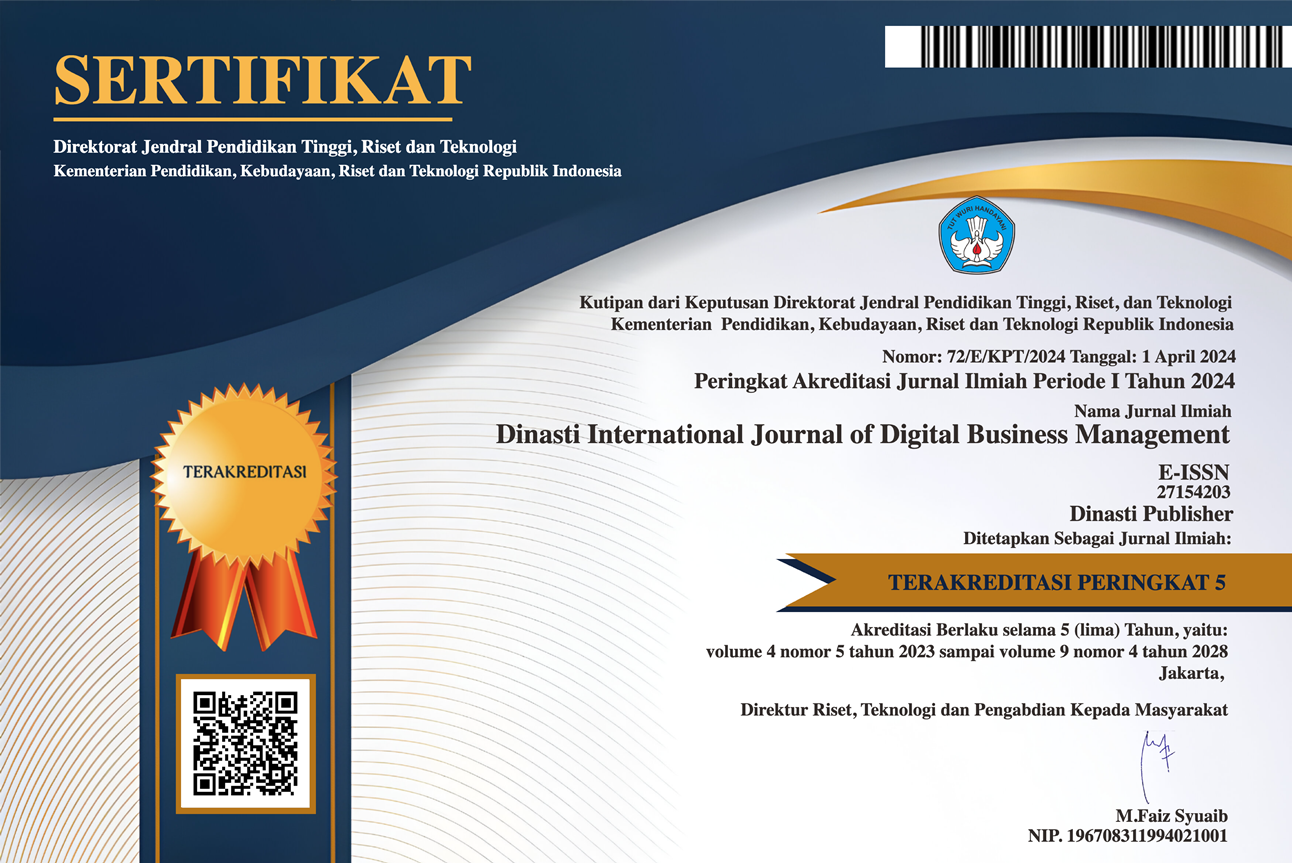The Role of Trust as a Mediator of Web Quality Perception, Risk, Reputation on The Intention to Repurchase Garuda Indonesia Ticket Online
DOI:
https://doi.org/10.38035/dijdbm.v6i2.4119Keywords:
Trust, Performance Expectancy, Information Quality, Ease of Use, ReputationAbstract
This study seeks to empirically investigate the factors influencing online repurchase intention for Garuda Indonesia's domestic airline tickets, with trust serving as a mediating variable. The study encompassed 201 participants, predominantly Millennials and Gen Z, who acquired tickets through Garuda Indonesia's official website or online travel agencies (OTAs). Data were analyzed with PLS-SEM. The results indicate that performance expectancy, information quality, perceived ease of use, and reputation have a favorable and significant effect on online repurchase intention. Trust also positively affects online repurchase intention. Nonetheless, trust does not facilitate the connections between design quality and perceived risk regarding online repurchase intention. Furthermore, design quality and perceived risk exhibit no significant direct consequences. These insights provide strategic implications for improving the effectiveness, efficiency, and competitiveness of Garuda Indonesia's digital platforms in the local market.
References
Adiratna, H. D., & Wulansari, A. (2021). Factors Influencing Purchase Intention of Elancing Using UTAUT Model: A Case Study of Mahajasa. Malaysian Journal of Social Sciences and Humanities (MJSSH), Volume 6(Issue 9), page 590 - 602. doi:https://doi.org/10.47405/mjssh.v6i9.1056
Ajzen, I. (1991). The Theory of Planned Behavior. Organizational Behavior and Human Decision Processes, 179-211.
Alhamdina, T. E., & Hartono, A. (2023). The Impact Of Brand Awareness, Brand Reputation, And Perceived Economic Benefits On Brand Trust And Online Purchase Intentions For Skintific Products On The Tiktok Shop Platform. International Journal of Science, Technology & Management, 4(03), 653-665. doi:https://doi.org/10.46729/ijstm.v4i3.832
Bhattacherjee, A. (2001). Understanding Informastion Systems Continuance: An Expectation-Confirmation Model. MIS Quaeterly, 25(3). doi:10.2307/3250921
Chandra, R. Y., & Martini, E. (2021). The Effect Of Website Design Quality, Service Quality, Trust and Satisfaction on Repurchase Intention (Case Study on The Website of JK Collection Shoes). e-Proceeding of Management, 8(5), 4735-4744.
Chang, K.-C., Kuo, N.-T., Hsu, C.-L., & Cheng, Y.-S. (2014). The Impact of Website Quality and Perceived Trust on Customer Purchase Intention in the Hotel Sector: Website Brand and Perceived Value as Moderators. International Journal of Innovation, Management and Technology,, 5(4), 255-260. doi:DOI: 10.7763/IJIMT.2014.V5.523
Chen, L., Rashidin, S., Song, F., Wang, Y., Javed, S., & Wang, J. (2021). Determinants of Consumer’s Purchase Intention on Fresh E-Commerce Platform: Perspective of UTAUT Model. SAGE Open, 1-17. doi:DOI: 10.1177/21582440211027875
Davis, F. D. (1989, September). Perceived Usefulness, Perceived Ease of Use, and User Acceptance of Information Technology. MIS Quarterly, Vol. 13(No. 3), 319-340. Dipetik July 6, 2024, dari http://www.jstor.org/stable/249008Accessed:
Giao, H. N., & Tuan, H. Q. (2021). Intention To Buy Air Ticket Online Of Vietnamese Consumers. Transportation Research Procedia 56, 143–150.
Guntur, B. M., Komariah, K., & Norisanti, N. (2023). Website Quality Analysis Of Purchase Intention Through E-Trust On The Thanksinsomnia Website. Management Studies and Entrepreneurship Journal, 4(2), 1988-1994.
Hair, J. F., Hult, G. T., Ringle, C. M., & Sarstedt, M. (2022). A primer on partial least squares structural equation modeling (PLS-SEM) (3rd ed.). Los Angeles: SAGE.
Huy, L. V., Thinh, N. H., Pham, L., & Strickler, C. (2019). Customer Trust and Purchase Intention: How Do Primary Website Service Quality Dimensions Matter in the Context of Luxury Hotels in Vietnam. International Journal of E-Services and Mobile Applications, 11(1). doi:10.4018/IJESMA.2019010101
Ilhamalimy, R. R., & Ali, H. (2021). Model Perceived Risk And Trust: E-Wom And Purchase Intention (The Role Of Trust Mediating In Online Shopping In Shopee Indonesia). Dinasti International Journal of Digital Business Management, 2(2), 204-221. doi:https://doi.org/10.31933/dijdbm.v2i1
Mariani, M., & Lamarauna, A. M. (2017). The Impact of Social Influence and Trust on Customer-to-Customer Online Shoppers’ Purchase Intention: An Empirical Study in Indonesia. GSTF Journal on Computing (JoC), 5(3), 1-6. doi:DOI: 10.5176/2251-3043_5.3.372
Mohamed, H. A., & Al-Azab, M. R. (2017). Exploring Key Factors That Influence Consumer Trust In Airline Websites. Journal of Association of Arab Universities for Tourism and Hospitality, 14(1), 91-110.
Oliver, R. L. (1980a, November 17). A Cognitive Model of The Antecedents and Qonsequences of Satisfaction Decesion. Journal of Marketing Research, 460-469.
Palementaria, S. B., Desideria, M., Setiawan, E. B., & Datunabolon. (2021). Increasing Repurchase Intention and Trust Through The Reputation of Airline Industry. Advances in Transportation and Logistics Research, 323-333.
Primanda, R., Setyaning, A. N., Hidayat, A., & Ekasasi, S. R. (2020). The Role of Trust on Perceived Usefulness and Perceived Ease of Use toward Purchase Intention among Yogyakarta’s Students. INOBIS: Jurnal Inovasi Bisnis dan Manajemen Indonesia, 03(03), 316-326. doi:https://doi.org/10.31842/jurnalinobis.v3i3
Qalati, S. A., Vela, E. G., Li, W., Dakhan, S. A., Thuy, T. T., & Meran, S. H. (2021). Effects of perceived service quality, website quality, and reputation on purchase intention. Cogent Business & Management, 1-20.
Safitri, & Ariyanti, M. (2019). The Influence of Website Quality on Trust and Impact on Purchase Intention. International Journal of Economics, Business and Management Research, 3(02), 86-103.
Sam, M. F., & Tahir, M. N. (2009). Website Quality And Consumer Online Purchase Intention Of Air Ticket. Electronic copy available at: http://ssrn.com/abstract=2255286, 9(10), 20-25. Diambil kembali dari https://ssrn.com/abstract=2255286
Singh, A., Alryalat, M. A., Alzubi, J. A., & Sarma, H. K. (2017). Understanding Jordanian Consumers’ Online Purchase Intentions: Integrating Trust to the UTAUT2 Framework. International Journal of Applied Engineering Research ISSN 0973-4562 , 12(20), 10258-10268.
Siu, P. M., & Ismail, K. (2022, August 01). Examining the Effects of Perceived Risk on Consumers’ Online Purchase Intention in Klang Valley. MANAGEMENT AND ACCOUNTING REVIEW, 21(2), 107-128. doi:https://doi.org/10.24191/MAR.V21i02-05
Utama, D. A., Fikri, M. A., & Rini, P. L. (2022). The Effect Perceived of Service Quality, Perceived of Website Quality, and Perceived of Website Reputation on Purchase Intention: The Mediation Role of Trust in Online Shopping. nternational Journal of Economics, Business and Accounting Research, 6(2), 836-846. Diambil kembali dari https://jurnal.stie-aas.ac.id/index.php/IJEBAR
Venkatesh , V., Morris, M. G., Davis, G. B., & Davis, F. D. (2003). User Acceptance of Information Technology: Toward A Unified View. Management Information Systems Research Center, University of Minnesota, 27(3), 425-478. Diambil kembali dari https://www.jstor.org/stable/30036540?origin=JSTOR-pdf
Downloads
Published
Issue
Section
License
Copyright (c) 2025 Aryo Wijoseno, Sri Hartono

This work is licensed under a Creative Commons Attribution 4.0 International License.
Authors who publish their manuscripts in this journal agree to the following conditions:
- The copyright on each article belongs to the author(s).
- The author acknowledges that the Dinasti International Journal of Digital Business Management (DIJDBM) has the right to be the first to publish with a Creative Commons Attribution 4.0 International license (Attribution 4.0 International (CC BY 4.0).
- Authors can submit articles separately, arrange for the non-exclusive distribution of manuscripts that have been published in this journal into other versions (e.g., sent to the author's institutional repository, publication into books, etc.), by acknowledging that the manuscript has been published for the first time in the Dinasti International Journal of Digital Business Management (DIJDBM).















































